The purpose of this Blog post is not to convince you that all your knives are inferior to these knives. At the end of the day, the best knife is a sharp knife. However, there is no doubt in my mind now after seeing these knives and using one, they can get an edge that few people have ever seen, especially in the Maritimes.
The Japanese knives I will speak of are the hand made single bevel knives that are designed/used for a specific purpose. Paderno in Halifax is the only store that I personally know of where I can walk in and purchase one.
In Japan, there is trio of these knives that are the most common and most widely used, while there are many many different types, the Holy Trinity of Japanese Traditional Knives consists of:
- The Usuba;
- The Deba; and
- The Yanagiba.
Japanese Chefs depend on all of these knives and they come a massive variety of names and quality. You can buy one online for less than $100.00 and take your chance or you can purchase a $3,500 Yanagiba and know that it is a treasure. Meticulously forged by a family who has spent their entire lives perfecting their knives and following in their fathers and grandfathers steps.
I believe that only the best chefs in Japan or in other parts of the world truly know how to use these knives. They are exceptionally sharp, yes sharper than any European or Canadian made knife and I will explain that a little later.
The link here will take you to the Korin website, Korin is in New York City and specialises in high end knives, the one here is over $7,000.
Exceptional Yanagiba
Let's talk about the three knives that are listed above. All of the images I have are from a wonderful book called Japanese Kitchen Knives Essential Techniques and Recipes by Hiromitsu Nozaki. I picked it up at The ikebana Shop on Quinpool Rd. (beautiful store). The book is awesome, beautiful illustrations and some very useful and interesting information.
Here it is:
The first thing I noticed about the MAC Deba I had in my hands at Paderno was the spine. It will blow you away, extremely thick compared to other knives, this is the hammer knife, the strong one, built to slice through bone. Again, the single bevel and steel (more on that later) leads to startling edge, if sharpened properly of course. This is one cool knife. It is also used for dressing poultry.
I don't own a Deba yet but I do have one coming. I don't intend to use it to break down a fish, I am getting it to learn how to sharpen it.
Now we get to what think is definitely the coolest knife in the world the Yanagiba.
Malcolm Smith, the Manager of Paderno and kitchen knife expert was kind enough to let me play with a quite expensive MAC Yangiba. I can tell you that I have seen many sharp knives, I have not seen anything sharper than that Yanagiba. (After I sharpened it of course :) )
The Yanagiba:
This is a very long and slender knife, professionals use a 14inch Yanagiba and a very specialized cutting technique, in fact, those "in the know" have many techniques to create jaw dropping food. Seriously, in the right hands, you would not believe what a pro can do with this knife.
The main purpose of this knife is to slice Sashimi, raw fish. The knife is pulled through the sashimi, it is delicate and purposeful motion.
Now the picture above is absolutely stunning in the book, I only put it here to try and illustrate what the knife can do in the right hands.
What makes these knives so good and why would I want one?
While there are many factors when blended together create stunning and beautiful knives, I guess the key ingredient has to be the steel. Note of course that not all these knives are of the same quality. To get what I consider a decent one, a Yanagiba for example, the minimum you would need to spend is $250.00.
I won't bore you by talking about the steel but you need to know this is what makes the knives so special. I mean besides the fact that they are hand made by artisans and not mass produced like our Henckels and Globals. So besides that, the steel in these knives, and that is mostly all carbon is very hard. Our Wusthof and Global knives are quite soft in comparison. This does mean that they are inferior, I have Globals and Wusthof, I'm not putting these knives down.
However because the steel is so hard, they can be sharpened and are sharpened at much acute angles and they can hold their edge much longer. So they are sharper and stay sharp longer.
The knives are thin, razor sharp and truly a joy to use.
Now these knives have not taken off in Canada like they have in the USA. Now I only know a couple of chefs, Peter Dewar, a gifted chef from the Valley has a couple and he was kind enough to let me sharpen them.
You will truly be amazed at how sharp these knives can get, I'm not kidding, remember, I couldn't care less if you had one, I'm not selling them, I just believe in them because I have seen them and used them.
There really is nothing like a sharp knife and when I say sharp, I don't mean out of the box, factory edge sharp, I mean water stone, hand sharpened sharp.
Does a sharp knife make you a better cook. Would having one of these knives, and you can get double beveled Japanese hand made knives somehow make you a better cook.
ABSOLUTELY.
Once you feel that thrill that a razor sharp knife can give you, it will enhance the joy of cooking for you, your senses will ignite, you'll be excited about cooking and that will motivate you to being a better cook.
Now.....you don't need one of these knives to feel that, I can sharpen your Grohmann and make it sharper than any knife that you likely have ever seen. You'll see what I mean.
I don't say this lightly, it's just science, it's the process of taking a knife edge over Japanese Water Stones, it just happens folks.
I don't understand people, especially Chefs who use dull knives. There is no excuse, the food being served to people is effected by dull knives.
I hope you enjoyed the little lesson on Japanese Traditional Knives.
Yes, you can cut other things with a Yanagiba besides raw fish :)
Until next time.
Let's talk about the three knives that are listed above. All of the images I have are from a wonderful book called Japanese Kitchen Knives Essential Techniques and Recipes by Hiromitsu Nozaki. I picked it up at The ikebana Shop on Quinpool Rd. (beautiful store). The book is awesome, beautiful illustrations and some very useful and interesting information.
Here it is:
The Usuba.
This is a vegetable knife:
 | |
|
Now if you gave me this knife as a gift, I would have no idea how to use it properly, i.e. use it to it's full potential. The book explains how apprentices spend years practicing with this blade. It seems pretty simple to me, it's just single bevel knife. Have you ever seen so impossibly thin slices of vegetables that seem, well they seem impossibly thin. This is the knife that is used for that and again, don't think that if you had this knife you are going to pull off some ridiculously impressive cutting achievements. However, you are going to look very cool trying. The Nakiri knife that is easy to find here, Wusthof, Shun, Global, MAC and others make them. They are double bevel knives designed to push cut through vegetables. I have one and it is my wife's favourite knife.
I have never even had a Usuba in my hands......more on that later and on sharpening this beauties.
So this knife is for turning vegetables into works of art. Every Japanese dish is plated with purpose, the arrangement of the vegetables and protein is never haphazard, is is planned, it is art and does not come easily.
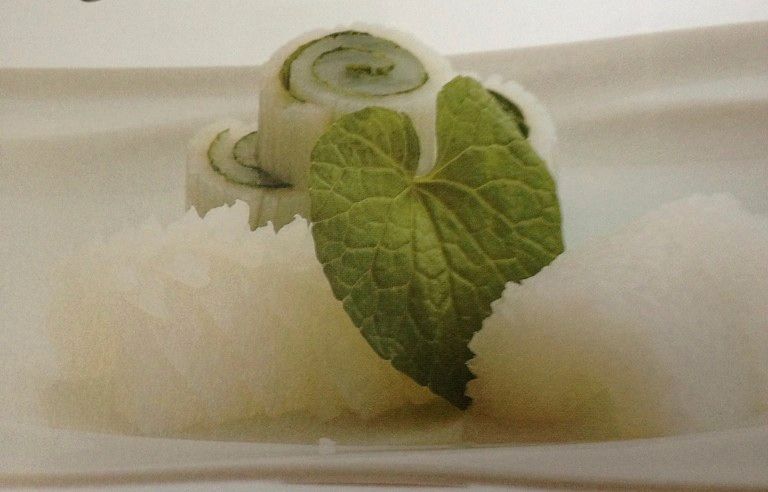 |
| Exquisite Picture from Japanese Kitchen Knives by Hiromitsu Nozaki |
Does the average Chef preparing traditional North American food need a Usuba. No, in fact I would say the average and above average chef doesn't know how to use a Usuba, just not a necessity.
Ok lets move to the next knife.
The DEBA
The Deba is a fish cutter, to be more precise, it is for breaking down a fish, it is a very strong knife, this is beast and is designed for a specific purpose, breaking down fish and filleting . Now if you have ever seen a Japanese chef cutting up a fish, you will astounded. It is a science, years of training and hundreds and hundreds of fish with this wonderful knife is needed to become the artist that some chefs are.
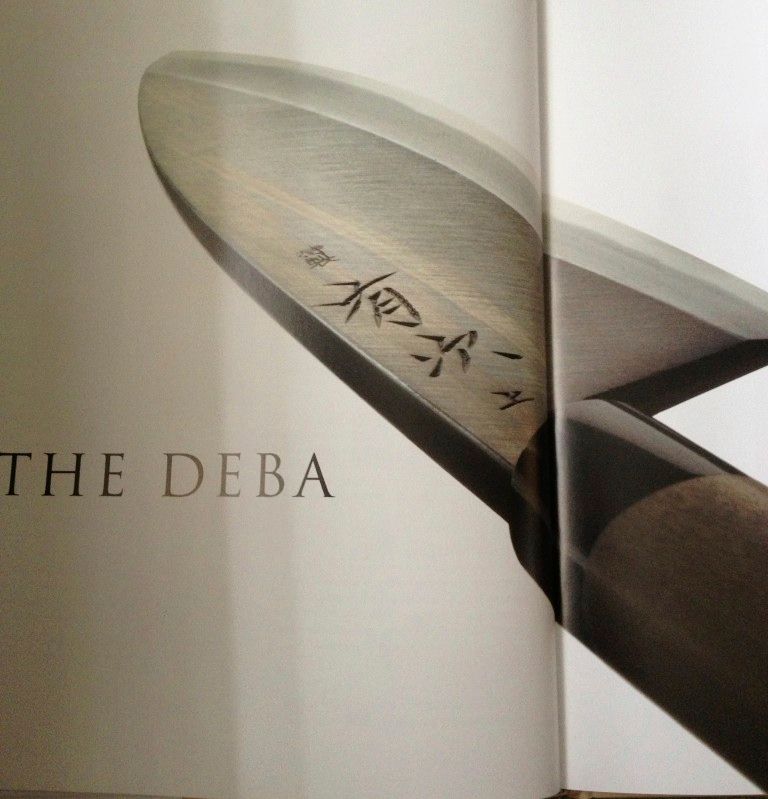 |
| Picture from Japanese Kitchen Knives by Hiromitsu Nozaki |
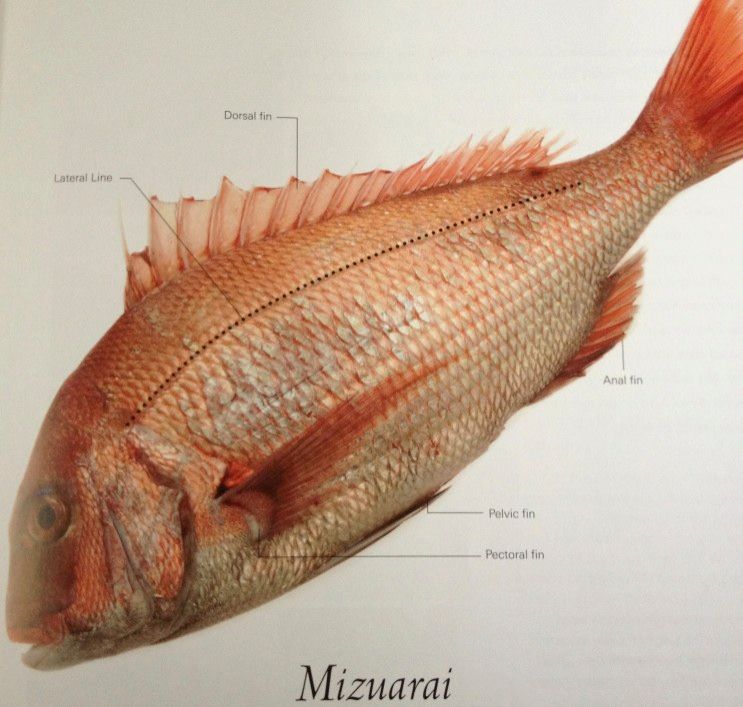 |
| Picture from Japanese Kitchen Knives by Hiromitsu Nozaki |
I don't own a Deba yet but I do have one coming. I don't intend to use it to break down a fish, I am getting it to learn how to sharpen it.
Now we get to what think is definitely the coolest knife in the world the Yanagiba.
Malcolm Smith, the Manager of Paderno and kitchen knife expert was kind enough to let me play with a quite expensive MAC Yangiba. I can tell you that I have seen many sharp knives, I have not seen anything sharper than that Yanagiba. (After I sharpened it of course :) )
The Yanagiba:
This is a very long and slender knife, professionals use a 14inch Yanagiba and a very specialized cutting technique, in fact, those "in the know" have many techniques to create jaw dropping food. Seriously, in the right hands, you would not believe what a pro can do with this knife.
The main purpose of this knife is to slice Sashimi, raw fish. The knife is pulled through the sashimi, it is delicate and purposeful motion.
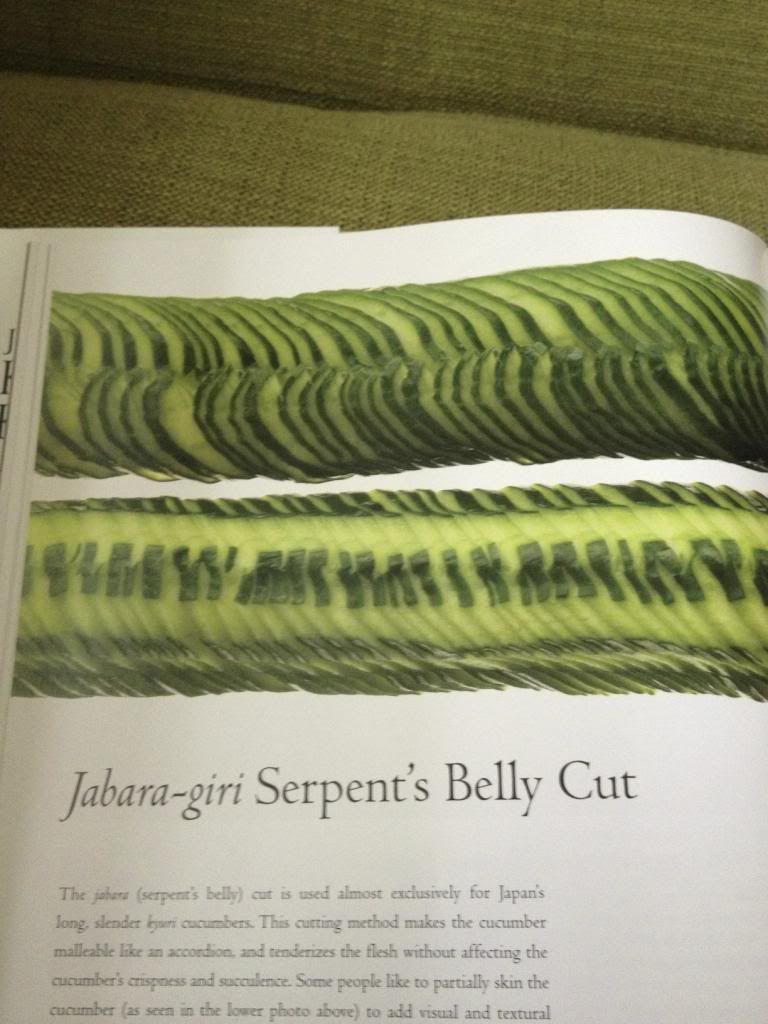 |
| Picture from Japanese Kitchen Knives Essential Techniques and Recipes |
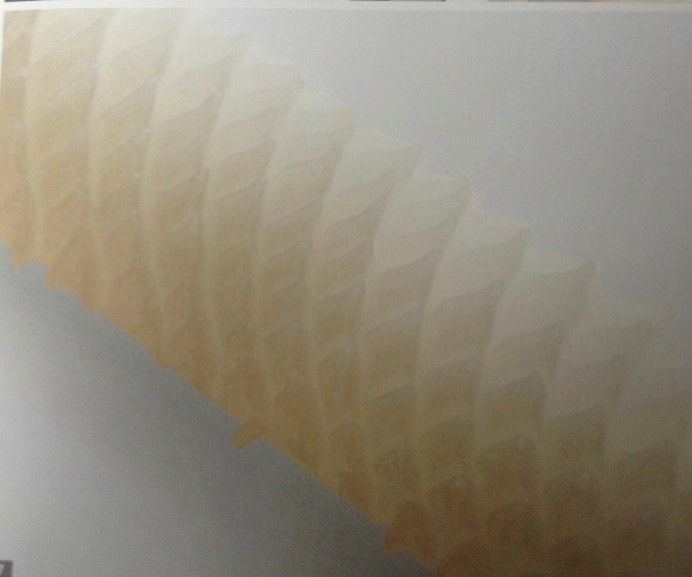 |
| Picture from Japanese Kitchen Knives Essential Techniques and Recipes |
Now the picture above is absolutely stunning in the book, I only put it here to try and illustrate what the knife can do in the right hands.
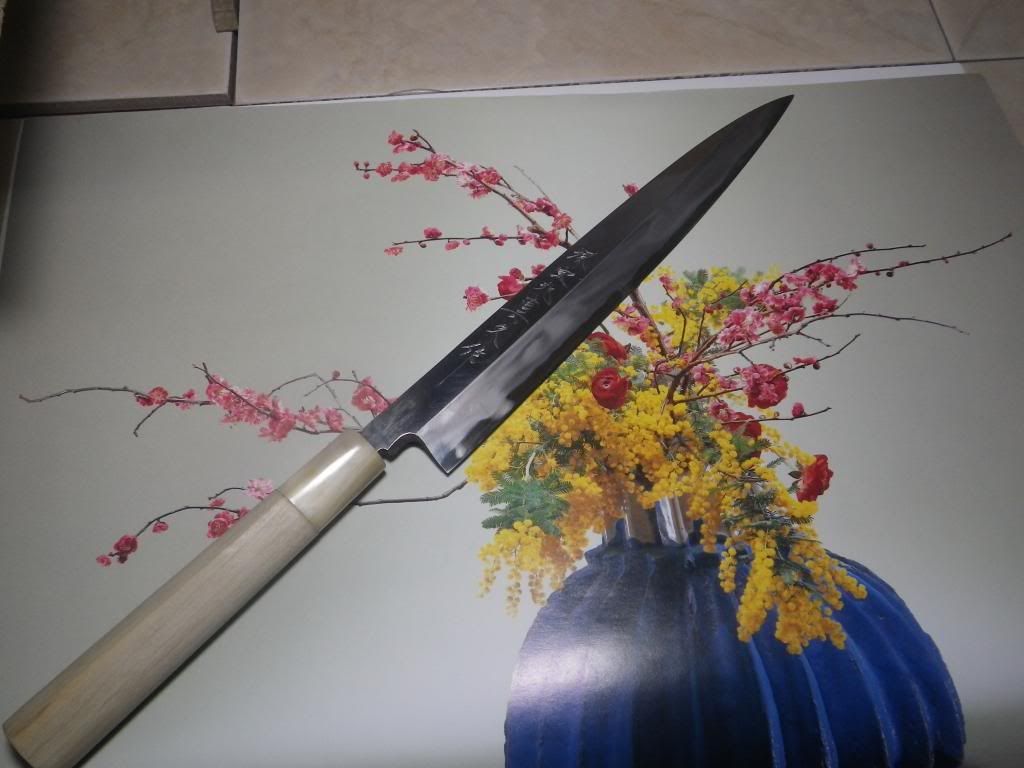 |
| MAC Yanagiba |
While there are many factors when blended together create stunning and beautiful knives, I guess the key ingredient has to be the steel. Note of course that not all these knives are of the same quality. To get what I consider a decent one, a Yanagiba for example, the minimum you would need to spend is $250.00.
I won't bore you by talking about the steel but you need to know this is what makes the knives so special. I mean besides the fact that they are hand made by artisans and not mass produced like our Henckels and Globals. So besides that, the steel in these knives, and that is mostly all carbon is very hard. Our Wusthof and Global knives are quite soft in comparison. This does mean that they are inferior, I have Globals and Wusthof, I'm not putting these knives down.
However because the steel is so hard, they can be sharpened and are sharpened at much acute angles and they can hold their edge much longer. So they are sharper and stay sharp longer.
The knives are thin, razor sharp and truly a joy to use.
Now these knives have not taken off in Canada like they have in the USA. Now I only know a couple of chefs, Peter Dewar, a gifted chef from the Valley has a couple and he was kind enough to let me sharpen them.
You will truly be amazed at how sharp these knives can get, I'm not kidding, remember, I couldn't care less if you had one, I'm not selling them, I just believe in them because I have seen them and used them.
There really is nothing like a sharp knife and when I say sharp, I don't mean out of the box, factory edge sharp, I mean water stone, hand sharpened sharp.
Does a sharp knife make you a better cook. Would having one of these knives, and you can get double beveled Japanese hand made knives somehow make you a better cook.
ABSOLUTELY.
Once you feel that thrill that a razor sharp knife can give you, it will enhance the joy of cooking for you, your senses will ignite, you'll be excited about cooking and that will motivate you to being a better cook.
Now.....you don't need one of these knives to feel that, I can sharpen your Grohmann and make it sharper than any knife that you likely have ever seen. You'll see what I mean.
I don't say this lightly, it's just science, it's the process of taking a knife edge over Japanese Water Stones, it just happens folks.
I don't understand people, especially Chefs who use dull knives. There is no excuse, the food being served to people is effected by dull knives.
I hope you enjoyed the little lesson on Japanese Traditional Knives.
Yes, you can cut other things with a Yanagiba besides raw fish :)
Until next time.
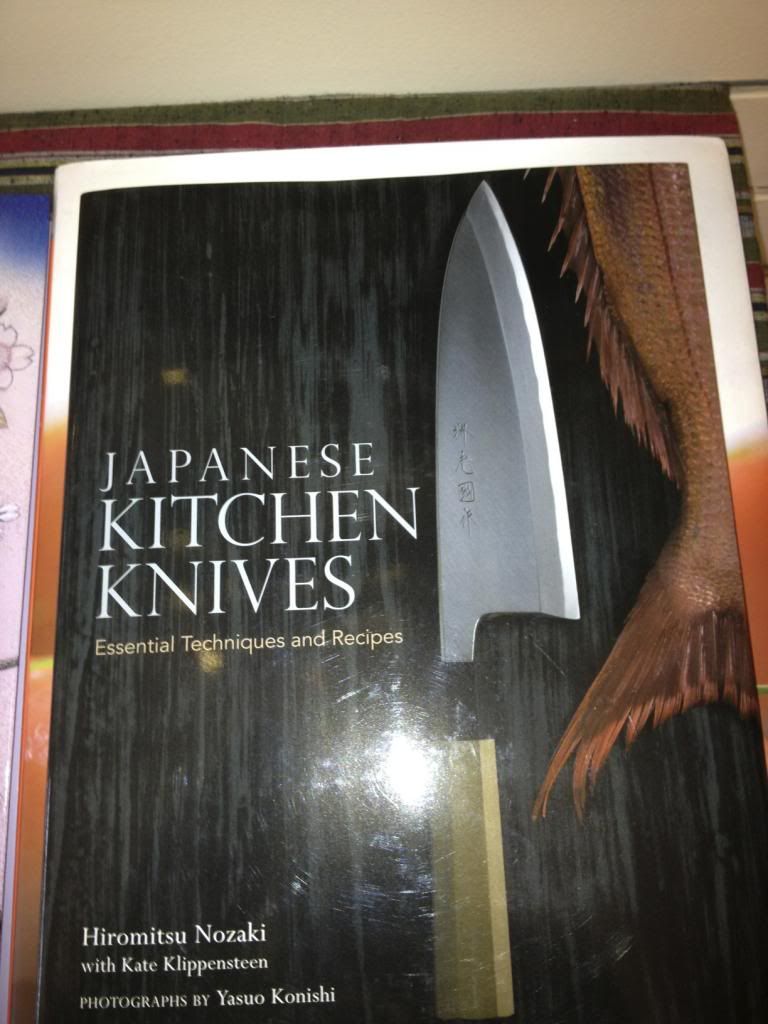

No comments:
Post a Comment